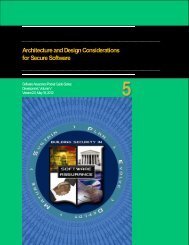Secure Coding SwA Pocket Guide - Build Security In - US-CERT
Secure Coding SwA Pocket Guide - Build Security In - US-CERT
Secure Coding SwA Pocket Guide - Build Security In - US-CERT
Create successful ePaper yourself
Turn your PDF publications into a flip-book with our unique Google optimized e-Paper software.
White listing, the preferred approach to input validation, verifies that input conforms todefined acceptable parameters and rejects all input that does not conform. White listvalidation has been proven to be effective in filtering out input patterns associated withunknown attacks. By contrast, the other approach, black listing, verifies that inputmatches defined unacceptable parameters associated with suspected malicious input.Black listing accepts all input that is not explicitly identified as “bad.” It is useless inprotecting against unknown attacks. It can, however, be useful in weeding out somebad input prior to white list filtering. It can also be used as a stopgap for filtering outattack input associated with zero-day vulnerabilities until a patch is available. Withblack listing, it is important to convert inputs to canonical form. White listing and blacklisting should be used in combination, with black listing occurring first.Validate programarguments that define» Length» Range» Format» TypeOnce the bad input is detected, it needs to be managed. The best approach is to simply reject the bad input, rather thanattempting to sanitize it. However, sanitization will sometimes be necessary. When that is the case, all data that are sanitizedshould be resubmitted for white list validation to ensure the sanitization was effective.Testing of input validation logic should verify the correctness of the input validation routines. The test scenarios should includesubmission of both valid and invalid data, and the tester should look for false positives (valid data rejected by input validation)and false negatives (invalid data accepted by input validation). If client-side validation is implemented as the first layer of filtering,it should also be tested with and without JavaScript. (JavaScript interprets regular expressions slightly differently than servervalidation engines do and can generate false positives on the client side and false negatives on the server side.) <strong>Security</strong> cannotdepend on client side testing as it may be possible to bypass client side elements. Finally, the tester should also run theapplication with validation turned off on both the server and client sides. Doing so will reveal how the receipt of invalid dataaffects other application tiers, and can expose vulnerabilities. <strong>In</strong> architectures in which input validation is centralized, testing willalso reveal whether additional validation may be needed at other points in the system. Ensure that validation cannot bebypassed. <strong>In</strong> a client/server design (such as a web browser and server) validation at the server is the only validation protectingthe server.CanonicalizationAn expression is canonical when it follows the standard format. Canonicalization is the process of reformatting an expression tofit this standard format. SAFECode gives the example that a document called “hello world.doc” can be opened several ways:» http://www.site.com/hello+world.doc» http://www.site.com/hello%20world.doc» http://www.site.com:80/hello%20world.docCanonicalization makes sure that expressions are converted to the standard format [SAFECode 2008]. Doing this beforevalidation reduces the risk of bypassing filters.LocalizationLocalization involves creating variants of a program for use in different countries. Abuse/misuse cases and attack models shouldbe developed for each localized variation of the software. The main problems associated with local variants relate to the potentialfor creating buffer overflow vulnerabilities due to the longer lengths of resource strings in some languages, the expression ofstring lengths in bytes versus characters in various character encodings, and the increase in required buffer size that can resultfrom conversions from one encoding to another.ParsersUse parsers to manage efforts such as encoding and translation. There are a number of encoding schemes, hex encoding,Unicode encoding, URL encoding, language-based character encoding. One of the challenges is that these encodings can beused together in forms of double encoding, making the canonicalization process a challenge. A series of built in parsers inapplications, such as web servers and application servers reduce this challenge to a manageable level. What remains is theissue of where input validation occurs – if it is a pattern-based method of validation, it is important that the check occur afterSoftware Assurance <strong>Pocket</strong> <strong>Guide</strong> Series:Development Volume VI – Version 2.0, , May 18, 2012<strong>Secure</strong> <strong>Coding</strong>15
















